In this post, we compare 3 of the best Slack survey apps available:
We start with our tool, Geekbot, which lets you run one-time or recurring surveys in Slack.
With Geekbot, you can customize the questions you ask (including how your team responds to the survey, from using their own words to multiple choice), pick whether the survey responses are anonymous or public, and more.
Geekbot is free for teams of 10 or fewer. For larger teams, Geekbot is $2.50 per user per month with an annual commitment or $3 per user per month for our month-to-month rate.
Click here to learn more and sign up.
1. Geekbot
When creating a survey in Slack, the first thing you want to do is choose “Build your own” from our list of meeting templates:
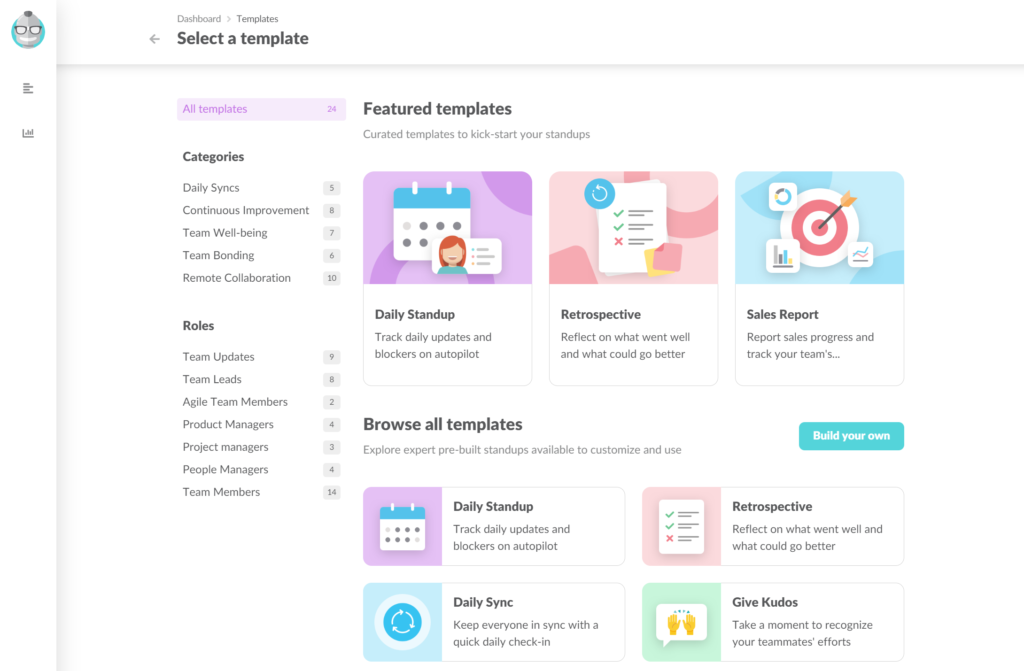
As you can see, Geekbot lets you do more than post surveys in Slack. We have ready-made templates for daily standups, well-being check-ins, retrospectives, and more.
When you click “Build your own”, you’re taken to our Custom Report screen.
Here you can fill out all the information you need to create and schedule your Slack survey.
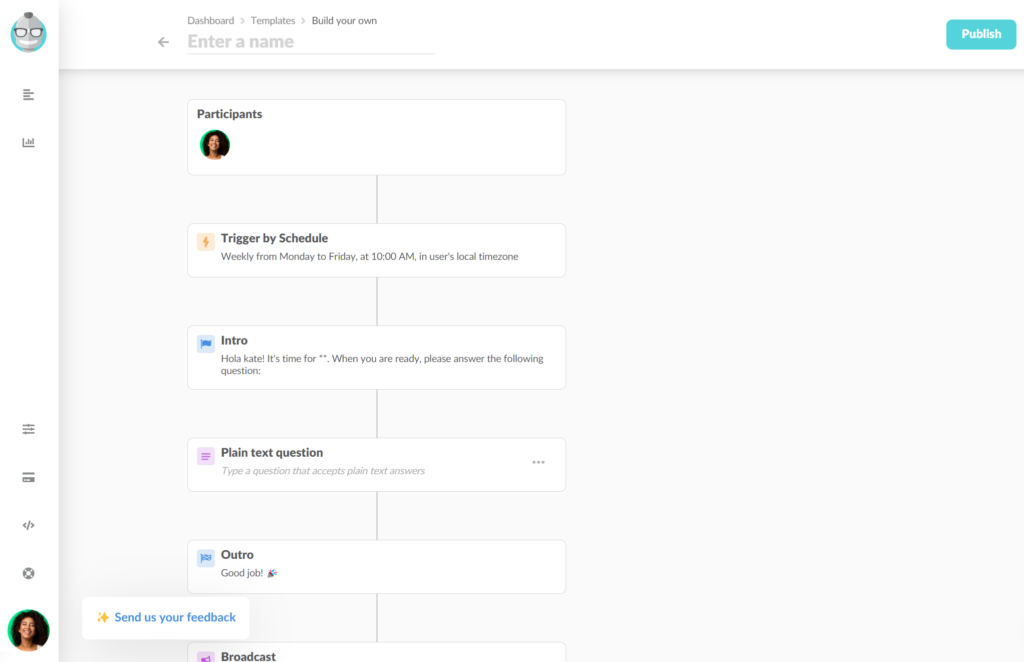
Below, we look at how you can customize every aspect of your survey.
Name Your Survey, Select the Appropriate Slack Channel, and Decide Whether It’s Anonymous or Not
The first thing you want to do is name your survey. This should be brief and clear — tell your team what the survey is about, whether that’s what to eat for lunch or a gauge on company culture.
Then you can pick where you want the survey broadcasted (i.e. the Slack channel where everyone’s responses are going to be shared).
With Geekbot, you can also select whether or not you want the survey to be anonymous.

If you’re doing an anonymous survey, then your team’s names won’t appear with their reports, which might be a good idea for more sensitive surveys about company culture or job satisfaction.
Customizing Your Geekbot Questions
With Geekbot, there’s no limit to how many questions you can put in your survey.
For example, you can have a question survey (like the example below) where your team responds on a scale of 1 to 5.
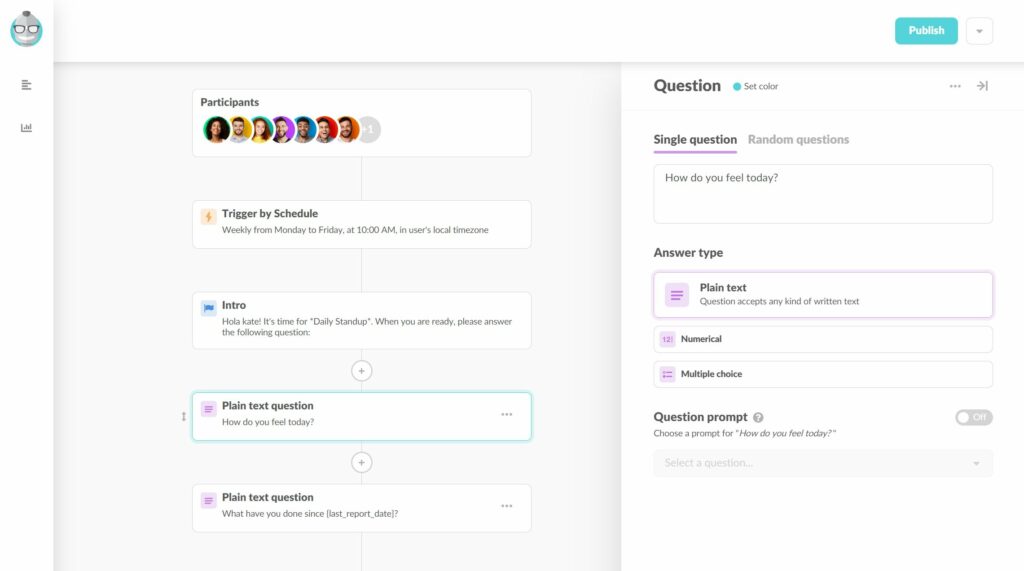
Or if you’re running a longer, more detailed survey, like an end-of-the-quarter review, then you can ask several questions. For example:
- In your own words, how did the whole team do over the last quarter?
- On a scale of 1-5, how would you rate the team’s ability to communicate?
- Which of these best describes how you felt at the end of the quarter? Pick one: A) Excited. B) Accomplished. C) Frustrated. D) Unsure.
This brings us to the next part: Choosing how your team fills out the survey.
Customizing Team Responses with Geekbot
With Geekbot, you can pick from several different response types:
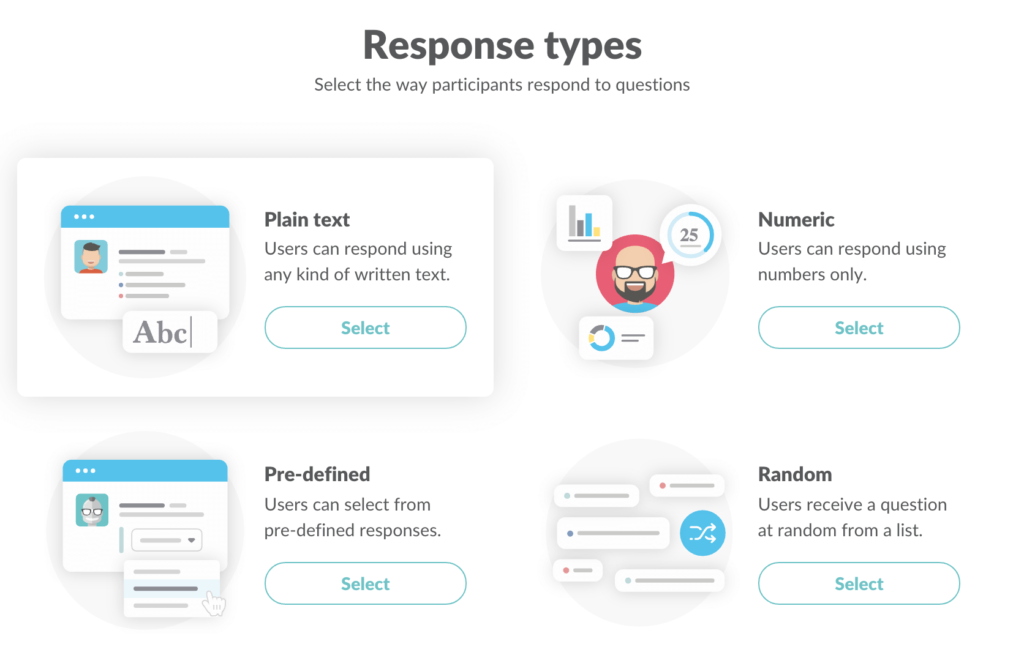
1. Plain text: Choose this when you want your team to respond in their own words. An example question is, “What features do you think should be added to the product?”
2. Pre-defined: If you choose this, then you’re giving your team pre-written answers to choose from. For example, if you’re doing a survey on what day next week would be best for the company-wide meeting, then you could list the options, “Tuesday,” “Wednesday,” and so on.
3. Numeric: This is for when you want a quantitative response. Your team can only respond by using numbers. If you want to gauge the overall effectiveness of a strategy, it’s best to ask on a numeric scale because it’s less subjective. If you ask someone how they felt about the strategy, you might get a bunch of responses that are hard to measure. But if you ask, on a scale of 1-5, how would you rate the success of our last sprint? The answers are going to be much more revealing.
Select Who Gets the Survey
With Geekbot, you can either sync your survey to a specific Slack channel (inviting everyone in that channel to respond) or you can manually pick which team members get the survey.
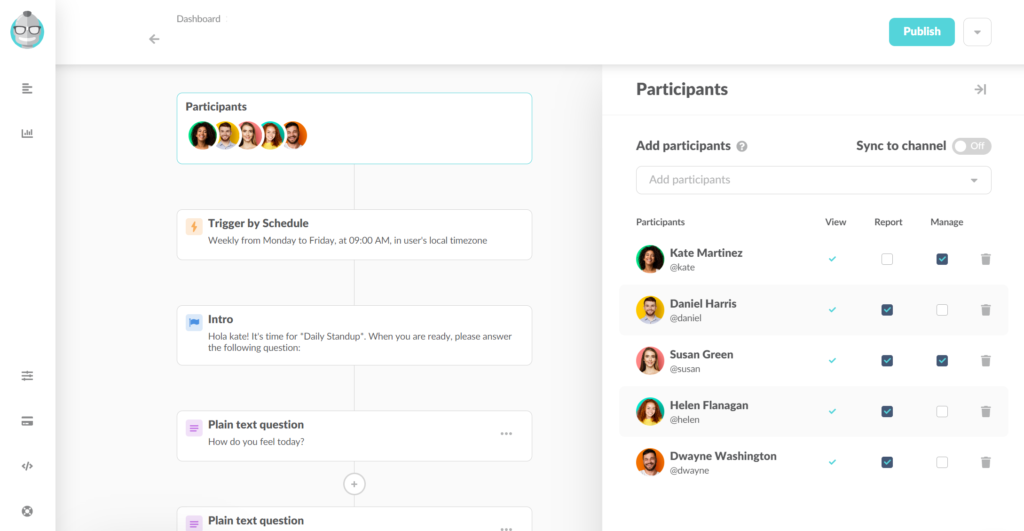
Schedule When You Want Your Survey to Go Out
With Geekbot, you can send out a one-time survey or create a recurring survey. Recurring surveys are great if you have an established calendar (e.g., end-of-the-month recaps).

You can pick what frequency you want the survey to go out, including which days of the week. You can also tell Geekbot to factor in everyone’s specific time zone.

This feature is really well-received by remote teams, especially remote teams that are doing daily standups and other Scrum meetings.
Let’s say your Scrum team is made up of distributed workers in both Europe and Asia. Without Geekbot factoring in local timezones, you’d either need to factor in local timezones yourself (which is a hassle) or just not factor them at all and send out meeting invites at awkward times.
For example, your London workers would get the notice to fill out their daily standup at 9:00 AM, and your Tokyo developers wouldn’t get their standup invite until 6:00 PM (which is inconvenient and disruptive to their evening).
Geekbot erases this problem by factoring in everyone’s local time zone. So both developers in London and Tokyo will get the standup at 9:00 AM their time.
Plus, if you have a traveling team member, every time their time zone changes, Geekbot takes note and sends the daily standup at the right time based on their current location.
This feature — which is so great for standups — is also great for surveys. It’s better to give teams a message from Geekbot during working hours. This way your survey request doesn’t interrupt their time away from work, and you’re more likely to get a response.
How Your Team Takes the Survey
Once you’ve filled out all of the appropriate fields, you can schedule when you want your Slack survey to go out. When it’s time, participants get a DM from Geekbot asking them to take the survey.

When you get your survey results, you can view them either directly in your Geekbot dashboard or via Slack:
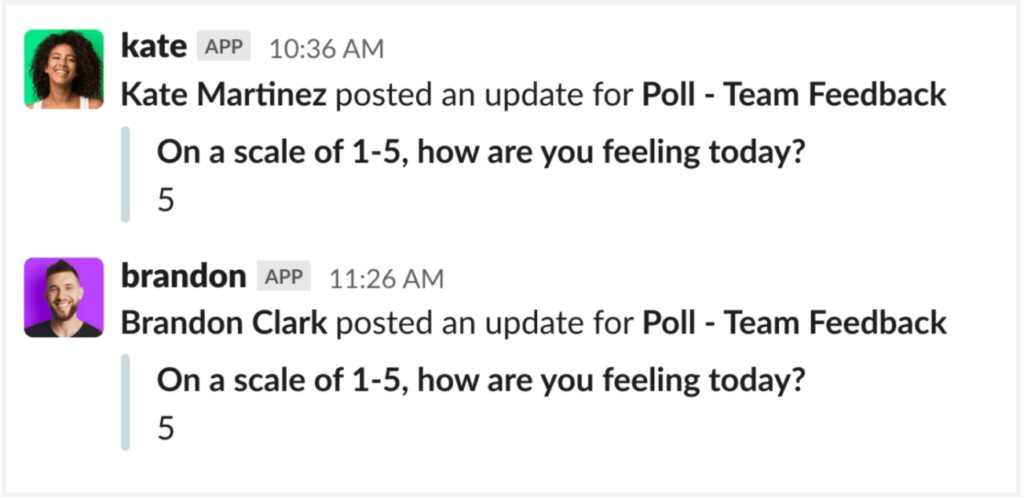
If you view them from your dashboard, you get additional insights such as participation rate (i.e. 14 out of 19 people filled out their survey today) and how many people on your team make a habit of filling out every report (i.e. Kate Martinez has completed 1248 consecutive surveys, followed by Brandon Clark with 748, and so on).
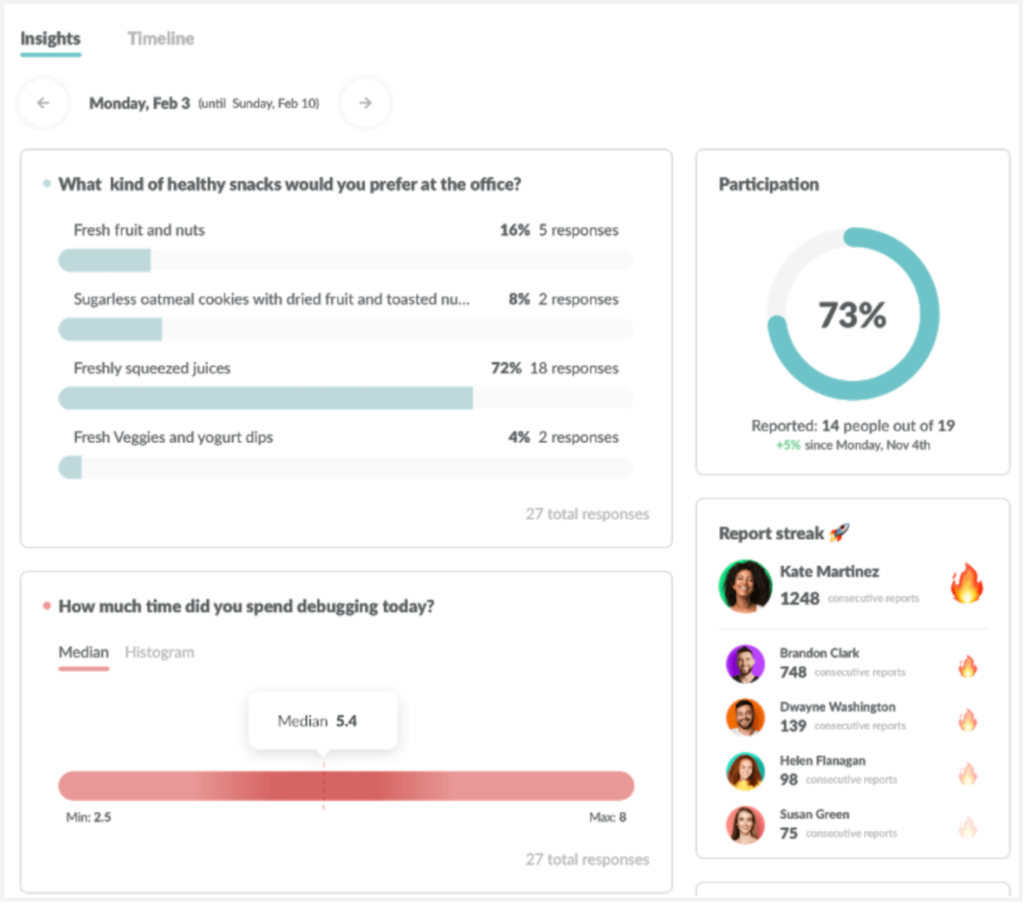
What we discussed above is what makes Geekbot a natural choice for creating and sending out surveys in Slack.
It’s quick and easy but can also grow and adapt to your team and its needs. It’s perfect for a quick survey where you want to see if the team wants pizza or sandwiches for Friday lunch, but you can also use it to figure out operational inefficiencies or where your team members are most frustrated with their job.
Further, these features are also great for holding different meetings, not just surveys.
Our customers use Geekbot for a variety of reasons, including:
- Holding asynchronous daily standups
- Holding asynchronous sprint retrospectives (along with tiered remote retrospectives)
- Holding remote learning check ins for educators
Geekbot is completely free for teams of 10 or fewer. For larger teams, you can either pay monthly ($3 per user month) or annually ($2.50 per user per month).
We’re dedicated to transparent and fair pricing, which means you only ever pay for the number of users who actively use Geekbot in a given month, not how many employees have signed up.
Learn more and sign up here, or keep reading below for some alternatives.
2. Polly.ai
Polly has a lot of the same features as Geekbot. With Polly, you can select response types, including multiple-choice questions, rating scales, and open-ended prompts. And like Geekbot, you can pick whether you want to send a one-off survey or set up a recurring one.
However, it might be more cost-effective for you to use Geekbot, depending on the size of your team. This is because Polly’s pricing plan works based on the number of surveys people respond to in a given period.
Here’s how Polly’s pricing works for Slack:
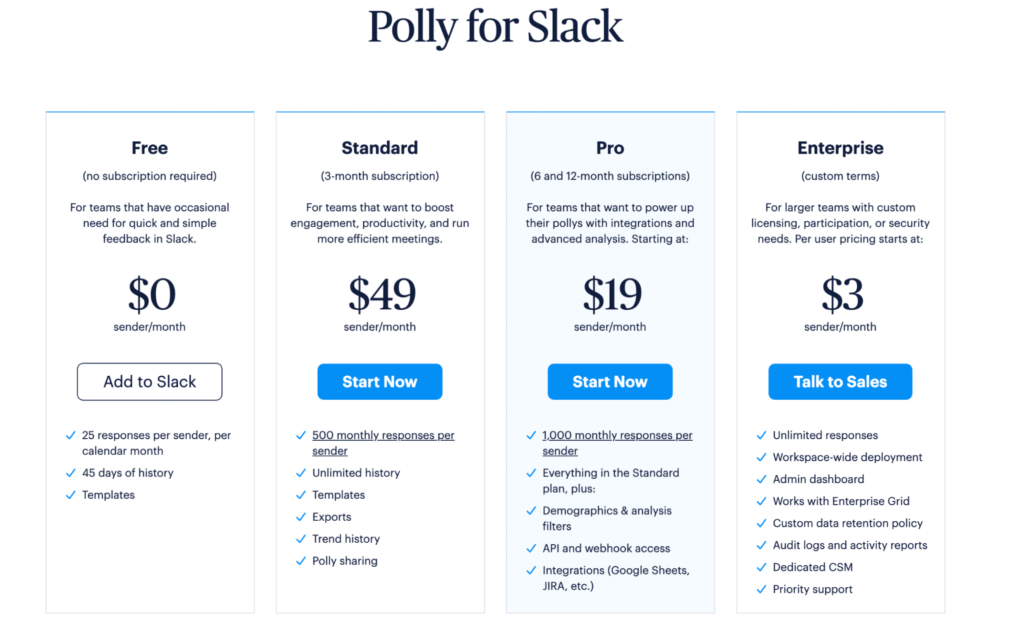
Note: A response isn’t based on how many questions a survey has but when someone on your team responds to any survey. So a 1 question survey counts as 1 response, just like a 10 question survey counts as one response.
1. Free: You get 25 responses per sender per calendar month. So if you have a team of 12, then you can do two surveys per month for free. Plus, on the free plan, you only get data on past surveys for 45 days before that info is deleted.
2. Standard: You get 500 responses per sender per month for $49. Let’s say you have a team of 15. That means you’re paying $3.20 per user (compare that to Geekbot’s $2.50 per user per month when on an annual plan). This price is only available with a 3-month subscription.
3. Pro: On the Pro plan, you get 1,000 monthly responses per sender for $19 per sender per month. While that seems cheaper, keep in mind that it’s per sender. If there are 1,000 surveys to send, they may not be coming from the same person. So let’s say that you have a management team of 10 that are constantly running surveys and polls. That’s $190 per month and you get the freedom to run up to 10,000 surveys. If you need that many, then Polly is worth considering. But if not, then perhaps it makes more sense to choose Geekbot (which has its pricing model based on how many people participate in a month, not how many surveys you send out).
4. Enterprise: The enterprise plan starts at $3 per sender per month, but it’s mostly based on a custom quote that you’ll get after talking to a Polly sales rep.
3. Simple Poll

Simple Poll is a straightforward tool where your team can only choose a predetermined response. So while it works great for questions such as “What day works best for our next all-hands meeting?” there’s no way to create a free-response survey (i.e. “What is a common theme that you’ve heard in talks with customers?”).
Visit this page to learn more about Simple Poll’s pricing and how the tool works.
Next Steps: Creating Your Free Survey in Slack with Geekbot
Using Geekbot to run surveys in Slack gives you the best of both worlds. Your surveys can be very simple and straight to the point. You can ask your team what type of pizza they want, and give them the choices of ham & pineapple, vegetable, or meat lovers. You can get that survey up and out in a matter of minutes and collect responses from everyone in the channel.
You can also use Geekbot’s advanced functionality to create more involved surveys — surveys that require your team to think out a longer, more nuanced response and surveys with various question types. You can set up recurring surveys and get them sent out to all of your remote workers based on their timezone.
Again, these features are free for teams of 10 or fewer. For larger teams, we offer monthly ($3 per user per month) or annual ($2.50 per user per month) pricing. But we only ever charge you based on how many users actively participated in a survey in a given month.
If you’re ready to get started, click here.
Enjoy this article? You may also like:
- How to Run Polls in Slack (in 6 Easy Steps!)
- 30 Slack Bots to Boost Your Team Productivity
- Zapier Blog: Why We Replaced Our Standups with a Robot
- The 3 Best Slack Poll Apps
Frequently asked questions
Can You Do a Survey in Slack?
Sometimes teams just want to do a simple survey in Slack without adding an app to their Slack workspace — is that possible?
Yes, but it’s limited. There’s only one way to do a survey in Slack, and it looks like this:
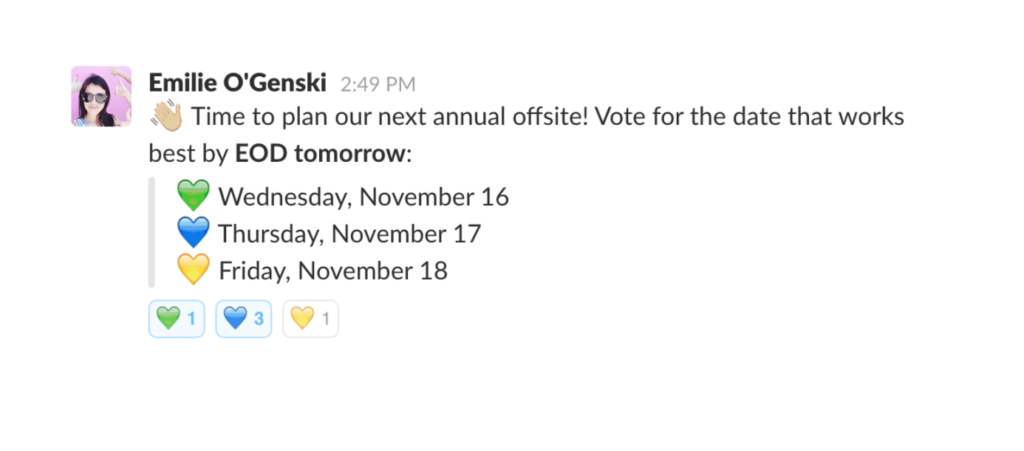
You create messages with different options. For example, let’s say you want to know which day next week is the best day for the office party.
You would write the question: “Which day next week is the best for the office party?” Then you’d write the possible answers: Wednesday, Thursday, Friday. Next to each answer would be a different emoji (a popular method is different colors of the heart emoji). Your team will use emoji reactions to show their vote.
If you want more functionality, then you need to look at the Slack app directory for a list of possible survey apps, like Geekbot.



